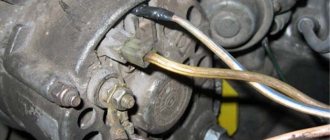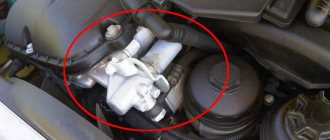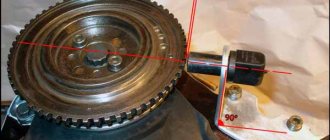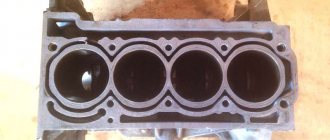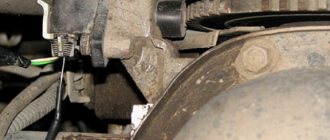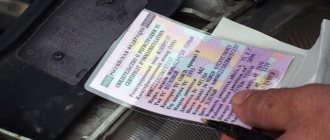Engine number 1.4 and 1.6 Hyundai Solaris and Kia Rio
The Rio/Solaris engine number does not rust and, due to its vertical position, is rarely covered with a thick layer of dust and dirt. Whatever the size of the engine, its marking is located on the front platform closer to the gearbox:
You can read the license plate symbols directly from additional devices like a mirror, but for a detailed analysis of the markings you will have to take photographs by inserting your phone between the radiator and the engine:
The area for the number must have a level cutter. Symbols are drawn with dots that overlap each other
The operational number can be found on the sticker on the valve cover. However, for those who like to wash the engine, this plate is often missing, since it comes off once or twice.
Basic data about the VIN of the body
The identification number is used during registration and legal procedures related to the vehicle. It is important information for identifying a vehicle and assessing its legality. The VIN is located on a chart mounted at the top of the dashboard and is visible from the outside through the car windshield. The identification plate, mounted on the B-pillar of the car body on the driver's or front passenger's side, contains the Kia Rio VIN from 2003 to 2021.
At different periods, various modifications of the car were produced:
Kia Rio 2012 model year, like other popular cars, was produced in different classes (small, medium, high). In this case, the information displayed on the number table is as follows:
Exterior and interior of Kia Rio 2021
The Rio model is a small passenger car, originally produced in 1999.
In May 2011, a Russified version of this car (in the third generation) appeared, differing from other regional versions in a more conservative external design.
The fourth generation of Rio, which launched on the Russian market in 2017, although it has undergone significant changes compared to its predecessor, still retains the general style of the exterior, the “muscular” look.
The same shapes can be seen in the appearance of the facelifted car of the 2021 model year, and the distinctive features of the “appearance” of the updated Kia Rio include:
- “luxurious”, almost triangular headlights, offered in the top with two lines of LEDs in the form of V lines;
- two decorative exhaust pipe tips on the sides of the rear bumper, this imitation emphasizes the sportiness of the car;
- the presence of a decorative strip connecting the rear lights.
Due to the change in the shape of the bumpers, the length of the car increased by 20 mm, other dimensions remained the same as before.
Also, the updated Rio, depending on the level of equipment, receives three types of head optics: reflective halogen, projection halogen (lensed) and LED.
In cheaper versions, the outer door handles are painted in body color, and the side window frames are black.
In the flagship configuration, the handles are silver, and chrome inserts are added in the frame of the front fog lights and window lines.
Although there are not too many changes in the restyling, it would be more correct to call it a “facelift,” but the car looks fresh and modern, attracting many car enthusiasts with its appearance, including the youth audience.
And it’s worth noting that this Kio Rio is not only popular in the Russian Federation, it is also the sales leader in the Russian market in its category of vehicles.
Engine KIA Rio X Line 1.4 Characteristics
All characteristics of the KIA Rio X-Line 1.4 engine are reflected in the table below.
| Brand | G4LC |
| Production | Beijing Hyundai Motor Co. |
| Cylinder block | Aluminum |
| Number of cylinders | 4 |
| Number of valves | 4 |
| Nutrition | Injector |
| Volume | 1,368 cm³ |
| Cylinder diameter | 72 mm |
| Piston stroke | 84 mm |
| Compression ratio | 10.5 units |
| Power | 100-110 l. With. |
| Torque | 130-140 Nm |
| Environmental standards | Euro 4/5 |
As you can see, the 1.4 G4LC is a simple in-line, naturally aspirated engine with 4 cylinders and 16 valves. On the Rio X-Line it produces 100 hp. With. at 6,000 rpm, and another 132 Nm of torque at 4,000 rpm.
As for the configurations, this power unit is available to customers exclusively in the basic Comfort configuration. It can work with a manual or automatic transmission (both are 6-speed).
Fuel consumption varies from 5 to 8.6 liters, which is quite at the level of modern standards.
Decoding the Kia Rio VIN number
The Kia Rio Vin contains information about ten parameters. For example, let's take this identification number:
- Z94CB41BBJR000001
- Z94 - means that the assembly took place at the HMMR plant in St. Petersburg;
- C is the code that the manufacturer uses to designate the Rio model itself;
- B – the vehicle belongs to the medium-small class;
- 4 – four-door sedan body (for station wagons – number 8);
- 1 – designation of passive safety systems, in this case the presence of a belt and airbags on both sides (zero means their absence);
- B – 1.6 liter engine (for the younger 1.4 engine there will be the letter A);
- B – steering wheel location and gearbox type, in this case left-hand drive and automatic (A – manual transmission; E – CVT);
- J – model year (not to be confused with the year of manufacture – more on that below), B – 2011; C – 2012; D – 2013, etc. In our case, 2019;
- R – Russian assembly;
- 000001 – no decoding is required here – it’s just the serial number of the car.
Vin Kia Rio contains the model year, which may not be the same as the year of manufacture. This is a term that defines the period of recent changes in a design.
Where is the power unit number usually applied?
Let's start with the fact that searching for a car's engine number for the usual selection of spare parts or determining the internal combustion engine model can be significantly simplified. This identifier, as a rule, is indicated in the registration documents for the car (in the registration document, vehicle registration certificate.) In other words, in order to find the engine number, you don’t even have to open the hood. They look for it in the engine compartment itself during the purchase or sale of a car, that is, during the verification of license plates when registering a car or after replacing the power unit. The last point should be understood as a complete replacement of the engine BC.
Otherwise, the engine marking is applied to the body of the unit; less often, it can be made on one of the basic components of the power plant. Often such elements are not removable. Let us add that in some cases the marker is made on removable units, but this practice is not widespread. The engine number itself is stamped on a separate marking plate, which is attached to the engine body using special rivets, solder, etc. Another option may be when the numbers and letters are stamped by the manufacturer directly on the engine. To detect it, you need to organize a backlight (flashlight), prepare a rust remover, gloves, rags and a brush with stiff metal bristles.
Where are the numbers (VIN) on KIA RIO
Where is the engine number on a Kia Rio?
HOW TO INVEST DOCUMENTS Regarding the purchase of a CAR.
I haven’t encountered it myself, but as I realized, these checks were started to replenish your own pocket, according to the law, inspections are not done, and when if you had an engine of the wrong model and with a different power than it was, it’s better for the police not to know about it if you didn’t register it as it’s supposed to), our client is left sad with the fines and is still tied up with the tax authorities
Horizontal platform on the block. If you look at the engine in front - the far right corner, near the intake manifold. It’s difficult to find, but it’s possible, if there’s a plastic cover on the engine, then take it off. What was it useful for? It seems that the engine is now considered an ordinary spare part; they do not inspect it.
An example of a stolen Hyundai Solaris
This Hyundai Solaris came to us after examination:
The owner bought the car without a full inspection before purchase. As a result, we could only confirm the fact that the markings had changed:
“Experts managed to restore the real markings”
Author: Denis Putkov, Autotorque.ru
Related article: Choosing a used Kia Rio 3, weaknesses, breakdowns
Engine number
It is important to know where the engine and body number may be located. For a Kia Rio car, the body number can be found under the front passenger seat, the engine number is on the front side. The Korean manufacturer has carefully thought out the placement of license plates, so their search is simplified for novice motorists and traffic police officers. Registration issues are resolved quickly and successfully.
Note! The engine number on a RIO car does not disappear, but over time it oxidizes and becomes dirty. The information becomes unreadable. It is recommended to regularly treat the table with silicone grease, graphite, Moville or tectyl. The procedure is repeated once every couple of months. Before an official event, it is enough to wipe with gasoline. This improves readability and simplifies procedures.
The engine marking is often applied to the unit housing or to a base component that is not removable. In rare cases, markings are located on removable units, as this is contrary to current legislation. The number is usually placed on a separate table, attached with rivets. Sometimes numbers and letters are stamped on the engine. To search for information, use cleaning agents to remove dirt and corrosion, gloves, and a flashlight.
Important! Kia is a well-known Korean car manufacturer that cares about its reputation. It offers cars with thoughtfully arranged number plates. Experienced motorists can easily find the engine number of the Kia Rio 3 on the front wall on the BC protrusion, or more precisely, under the filler neck intended for pouring technical fluid into the engine cooling system. This approach is relevant for 1.6 and 1.4 engines.
It is usually easy to find the engine number on a Kia Rio if you know the location of the number table. This is required during official and registration procedures related to a specific vehicle. Both code combinations are indicated in the car’s registration certificate and in technical transport, so in ordinary life you can find out the information without opening the car hood.
Where is the VIN number for Kia Rio 2?
Vin number, or plates with registration data, are located on the Kia Rio 2:
- Under the passenger seat, in the front. The main VIN number is located under the car seat. It is easy to see if you look under an easy chair.
- On the B-pillar of the door, on the driver's side. The marking duplicate table is located here.
And the last place for the VIN number is under the windshield, on the driver’s side.
Device
In general, the engine, by modern standards, is not too complex. The KIA Rio X Line 1.4 engine block is cast from aluminum with dry cast iron liners (thin-walled), which are poured in during the production process.
Fuel supply – MPI distributed injection with an injector, with a compression ratio of 10.5 units.
The engine has lightweight pistons and 2 camshafts. The design also provides for the presence of 2 phase shifters and an inlet pipeline with variable length. The timing drive is chain.
When creating this unit, the designers focused primarily on reducing weight and reducing fuel consumption, which they completely succeeded in doing.
Engine kia rio 2 (jb)
For the Russian market, Kia Rio cars are equipped with a G4EE gasoline engine (1.4 l, 16V 97 hp), the main components of which are shown in Fig. 5.1.
Rice. 5.1. G4EE engine (main components): 1 — oil filler plug; 2 — oil filler plug gasket; 3.6 - bolts; 4 — cylinder head cover; 5 — cylinder head cover gasket; 7 — cylinder head; 8 — cylinder head gasket; 9 - cylinder block assembly with crank mechanism and oil sump
The engine has two overhead camshafts and four valves per cylinder. The camshafts are driven by a reinforced timing belt, and only the exhaust camshaft is driven by the belt. The intake camshaft is driven from the exhaust camshaft by a chain.
Gaps in the valve drive are eliminated by hydraulic compensators connected by channels to the lubrication system.
Cylinder block 10 (Fig. 5.2) of the engine is a single casting that forms the cylinders, cooling jacket and oil line channels. It is made of special high-strength cast iron, the cylinders are bored directly into the body of the block. The cylinder block has special bosses, flanges and holes for fastening parts, assemblies and assemblies, as well as channels for the main oil line.
Rice. 5.2. Cylinder block, crankshaft and oil sump: 1 - oil sump; 2 — sealing ring of the oil drain plug; 3 - oil drain plug; 4, 9,14,15,18, 24, 25 - bolts; 5 — oil receiver; 6 — oil receiver gasket; 7 - oil pump; 8 — front crankshaft oil seal; 10 — cylinder block; 11 — rear shield of the cylinder block; 12 — drive disk of the torque converter (only for a car with an automatic transmission); 13 — reinforcing ring of the torque converter drive disk (only for cars with an automatic transmission); 16 — flywheel (only for cars with a manual transmission); 17 — rear crankshaft oil seal; 19 — crankshaft rear oil seal holder; 20 - upper crankshaft main bearing shell; 21 - crankshaft; 22 - lower crankshaft main bearing shell; 23 - crankshaft main bearing cover
The crankshaft 21 is five-bearing, cast from special high-strength cast iron. It has eight counterweights, manufactured integrally with the shaft. To supply oil from the main journals to the connecting rods, drillings are made in the crankshaft. The axial movement of the crankshaft is limited by the lower 22 and upper 20 shells of the third main bearing, which have thrust collars.
A toothed camshaft drive pulley is installed at the front end of the crankshaft. A cast iron flywheel 16 with a pressed-on ring gear is attached to the crankshaft flange of cars with a manual transmission. On vehicles with an automatic transmission, the drive disk 12 of the torque converter is attached to the crankshaft flange.
Flywheel 16, cast from cast iron, is installed at the rear end of the crankshaft and secured with five bolts 15. A toothed rim is pressed onto the flywheel to start the engine with a starter.
